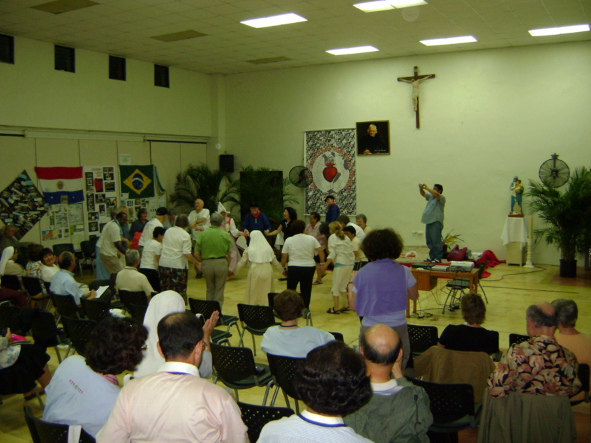Laity of the Chevalier Family
The three congregations and the laity share a common spirit:
- A deep concern for all of humanity;
- A belief in the love of God revealed in Jesus, as an answer to people’s deep needs;
- A mission to give witness of this love to all people, through the practice of kindness and compassion.
Jules Chevalier’s Charism and the Identity of the Chevalier Family; H Kwakman MSC, page 11
In 1864 Chevalier came up with his ‘Plan of the Society of the Missionaries of the Sacred Heart’, in which he stated: ‘in order to fulfil its mission, the Society must spread as much as possible, but it will spread only so far as it answers the aspirations of the people.’ In this Society, as he envisaged it, there should be a place for a variety of people. Firstly, ‘the religious’, consisting of priests and brothers with vows of poverty, obedience and chastity; these religious were named Missionaries of the Sacred Heart and lived together in religious communities. Secondly, diocesan priests … and thirdly, lay-people, men and woman, who belonged to the Third Order of the Sacred Heart of Jesus.
‘ The sort of life to which members of the Third Order of the Sacred Heart of Jesus devote themselves is this; to remain in their families, to carry out the duties of their state of life, to retain freedom of activity in the world, and nevertheless, to aim for perfection, to put no limit on their devotion to Our Lord, and to carry out in society an apostolate which is all the more useful in that it does not give rise to mistrust.’
Jules Chevalier, Tiers Ordre, 1865, quoted in Kwakman, page 82
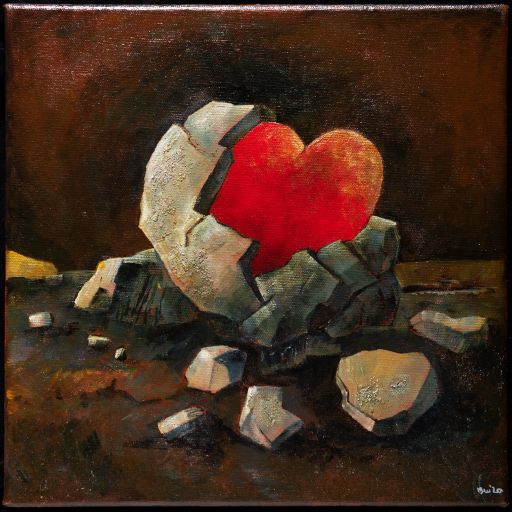 Image: A New Heart - Bruce Woods (used with permission)
Image: A New Heart - Bruce Woods (used with permission)
I will give you a new heart and put a new spirit in you; I will remove from you your heart of stone and give you a heart of flesh. Ezekiel 36:26
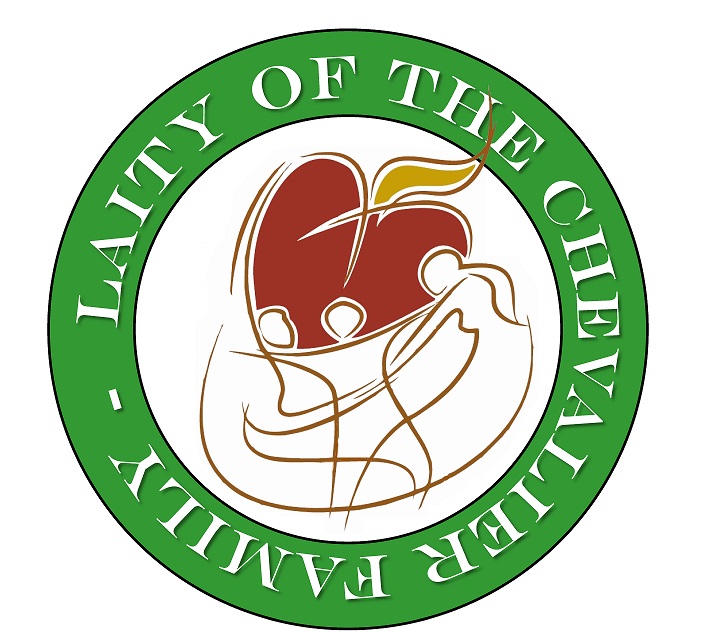
The Logo of the Chevalier Family was designed in Brazil for use at the Third International Assembly of Laity of the Chevalier Family. In many ways, this Assembly marked the formal birth of the international, national and regional structures of the movement, and it was where the Guiding Principles and Statutes were adopted. The Logo depicts the spirit and essence of the emerging movement of laity at that Assembly and has since been adopted by both the International Council and many National Councils as their own.
The Logo is quite distinctive in its features and is different from the explicitly Christian images of the MSC, FDNSC and the MSC Sisters. While the key symbols of Spirituality of the Heart are present in the recognisable, but softly drawn Sacred Heart and Cross of Jesus, the Logo also contains strong images of the human interconnection and interrelationship that are identifying features of our shared charism, yet at the same time point to the distinctiveness of our Lay Charism, where we live in families, we earn our living in our communities and we commit ourselves in a way that is different from professed members. When the images are considered through the eyes of our Charism they point us to foundational scriptures: since it is in him (LOVE) that we live and move and exist (Acts 17:28) and this LOVE of God has been poured into our hearts by the Holy Spirit which has been given to us (Romans 5:5) and whoever fails to LOVE does not know God, because God is LOVE. (1 Jn 4: 8)
The centrality but openness of the heart: the universal symbol for love, human and divine, draws us to the transformation of our own hearts that comes through our offering of our lives to the Heart of Christ. This offering leads us to encounter for ourselves the love of God. It is from this transforming encounter that our interconnection and relationality flows. The configuration of the figures reflects this understanding. Their shape and posture are gently intertwined, but loosely held; the different forms are reflective of gender, culture and worldview, but most importantly, all flow from the Heart of Christ. We are diverse, yet animated by the same source. Our interconnection leads us deeply into the pain and suffering of the world, which could overwhelm us but for the Hope of Christ which is poured into our hearts to be a source of hope for others. It is from the flame of the charism that this transforming hope flows out of the heart encircling the people.
The flame of charism connects the interior symbols to the outer circle. The use of green, signifying hope, encircles the central image and symbolically reflects creation, in which we live and from which we are sustained. Spirituality of the Heart recognises that creation powerfully reflects a God of life and relationship and reminds us, as laity, of our sacred task to commit to the preservation and protection of the creation from which all life comes. This understanding is enhanced through the depiction of our name within the circle of creation and by the flame of our charism pointing directly to our name. This clearly identifies the place of the laity within the Chevalier Family as a group that is distinct, yet completely connected to the common vision.
The Logo is dancing; its gentle strength is reflective of the central place of Mary, Our Lady of the Sacred Heart, in our charism and draws us into the love between Jesus and Mary that flows from them to us and all creation, enabling us to participate in the joyful dance of love.
The Logo calls us, as members of the Laity of the Chevalier Family, to participate in the creation of hope, meaning and purpose which is the birthright of all humanity.
In recent times, the European laity were the first group to develop autonomous structures enabling them to live the vision of Fr Chevalier alongside the professed. They undertook much of the initial work involved in bringing to birth the vision of an International Family of Laity.
In 1995, for the first time, an international ‘lay meeting’ was organised in Issoudun, France with limited participation of people from outside of Europe.
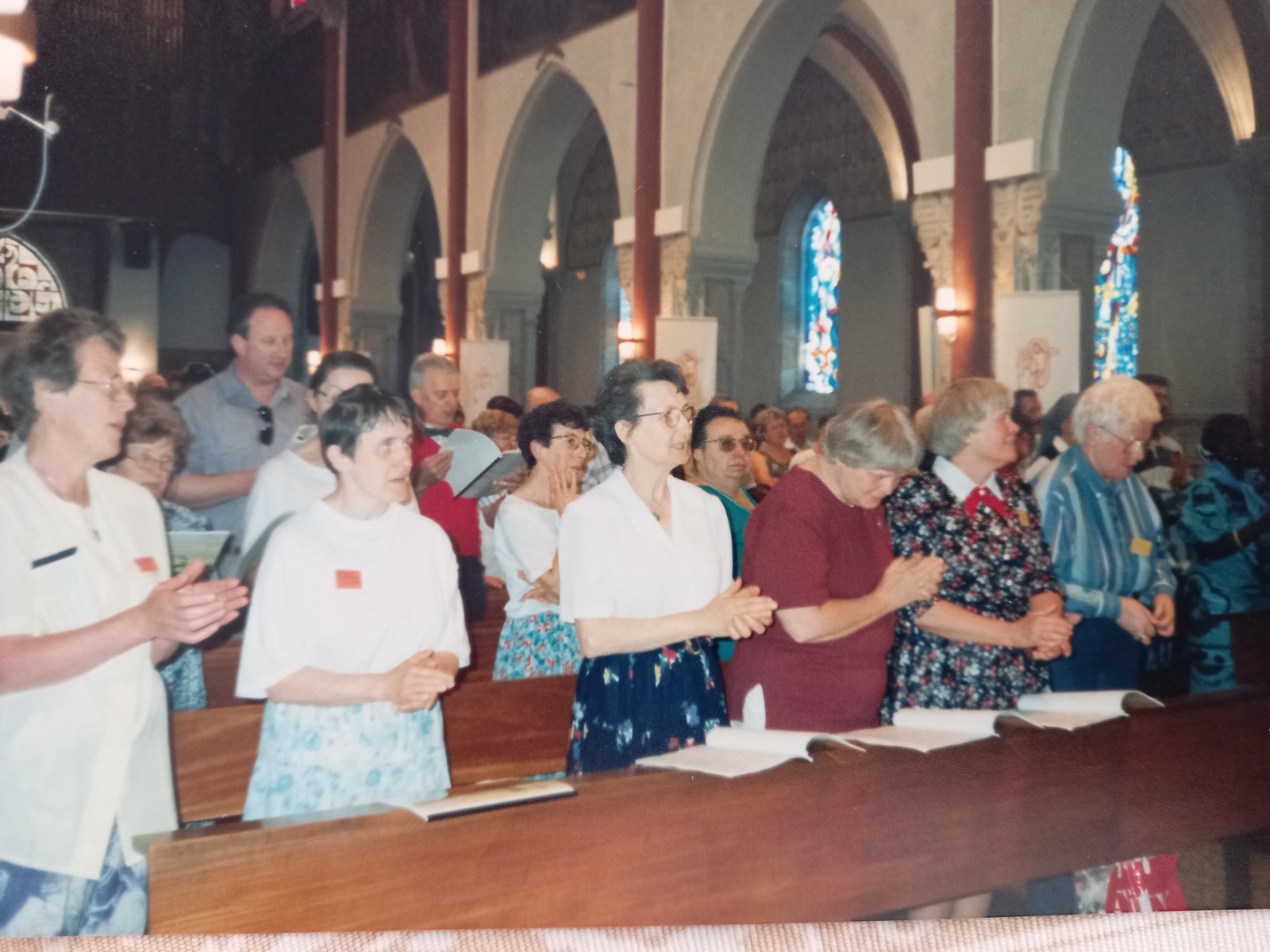 |
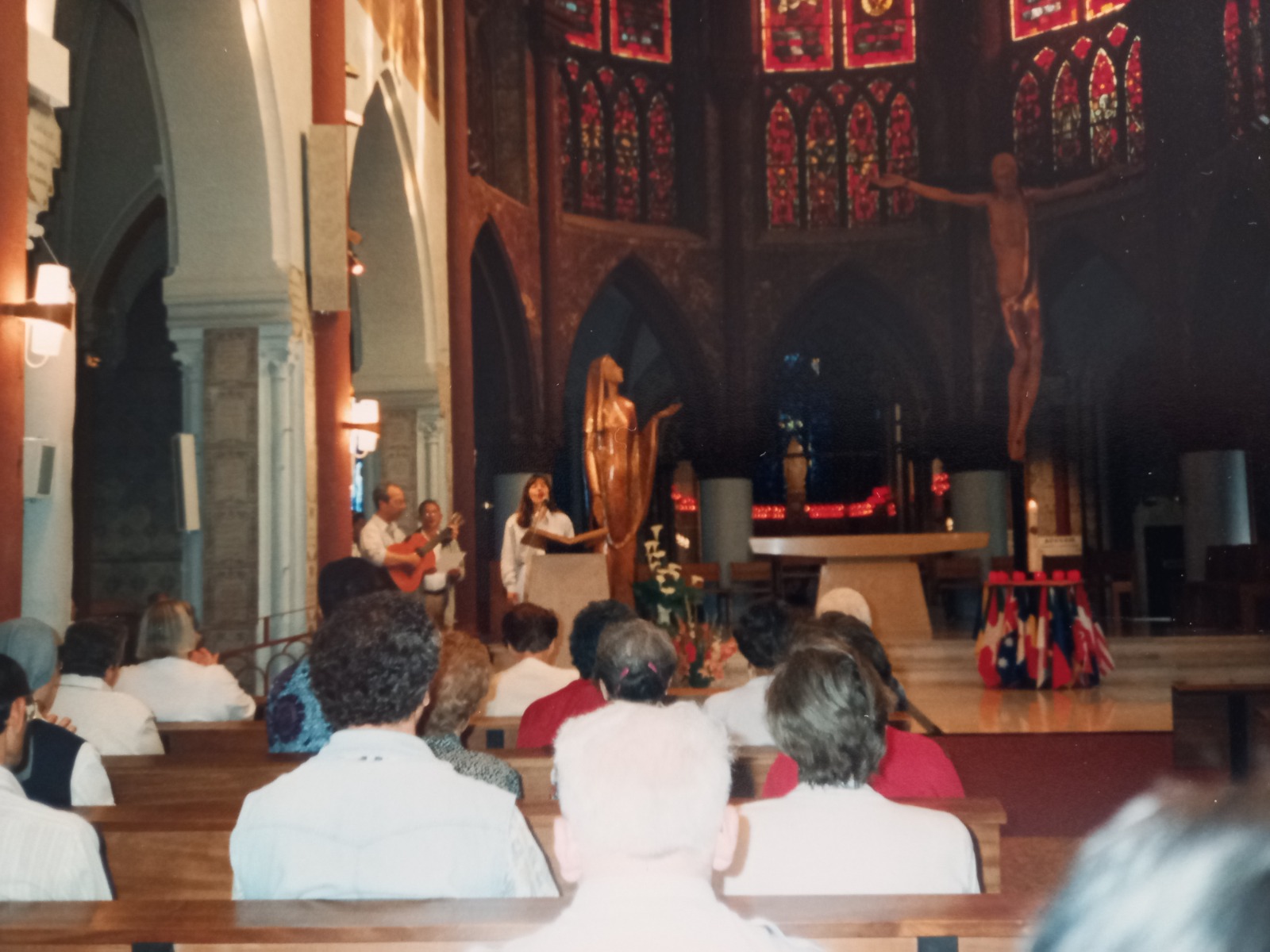 |
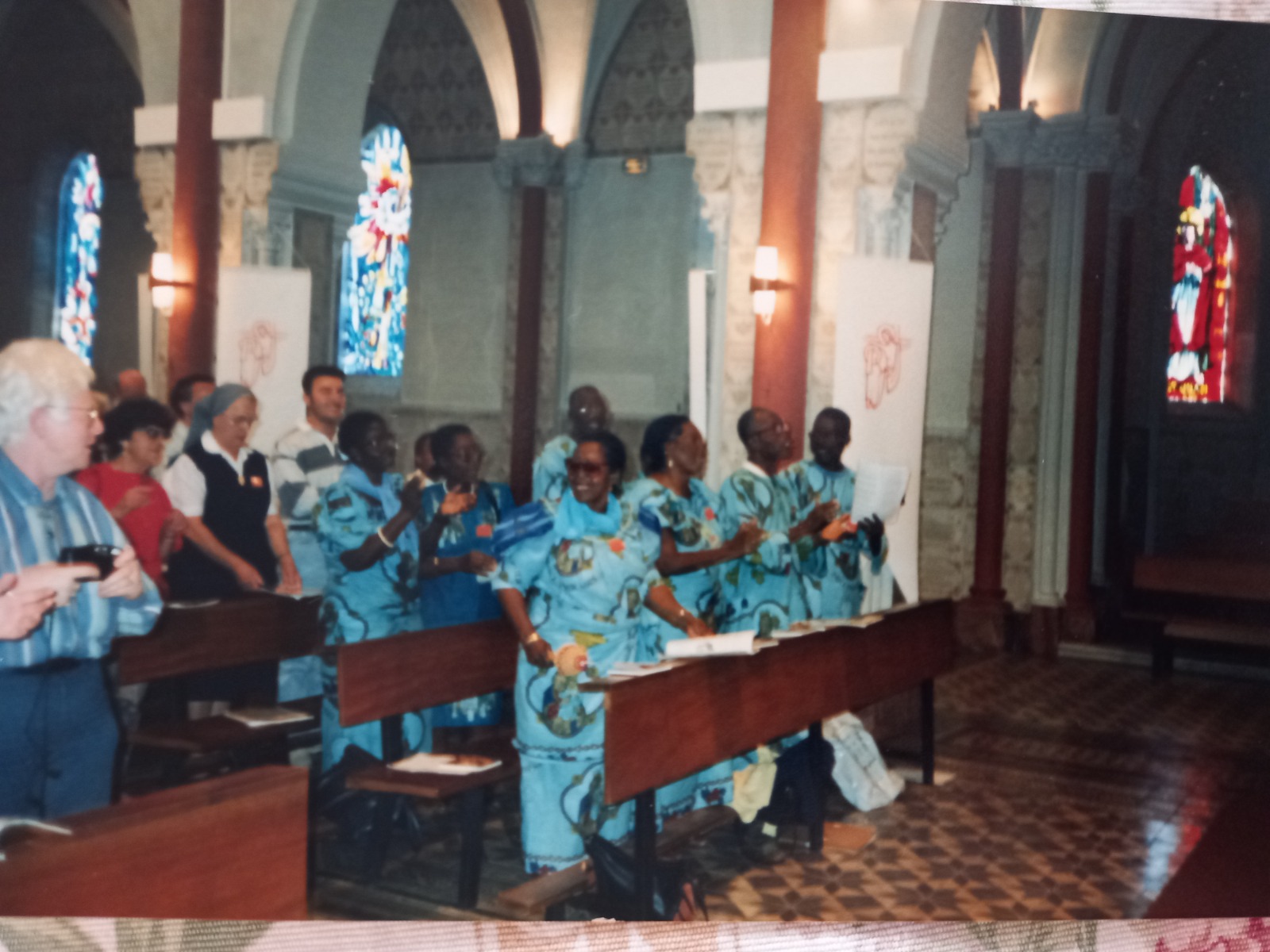 |
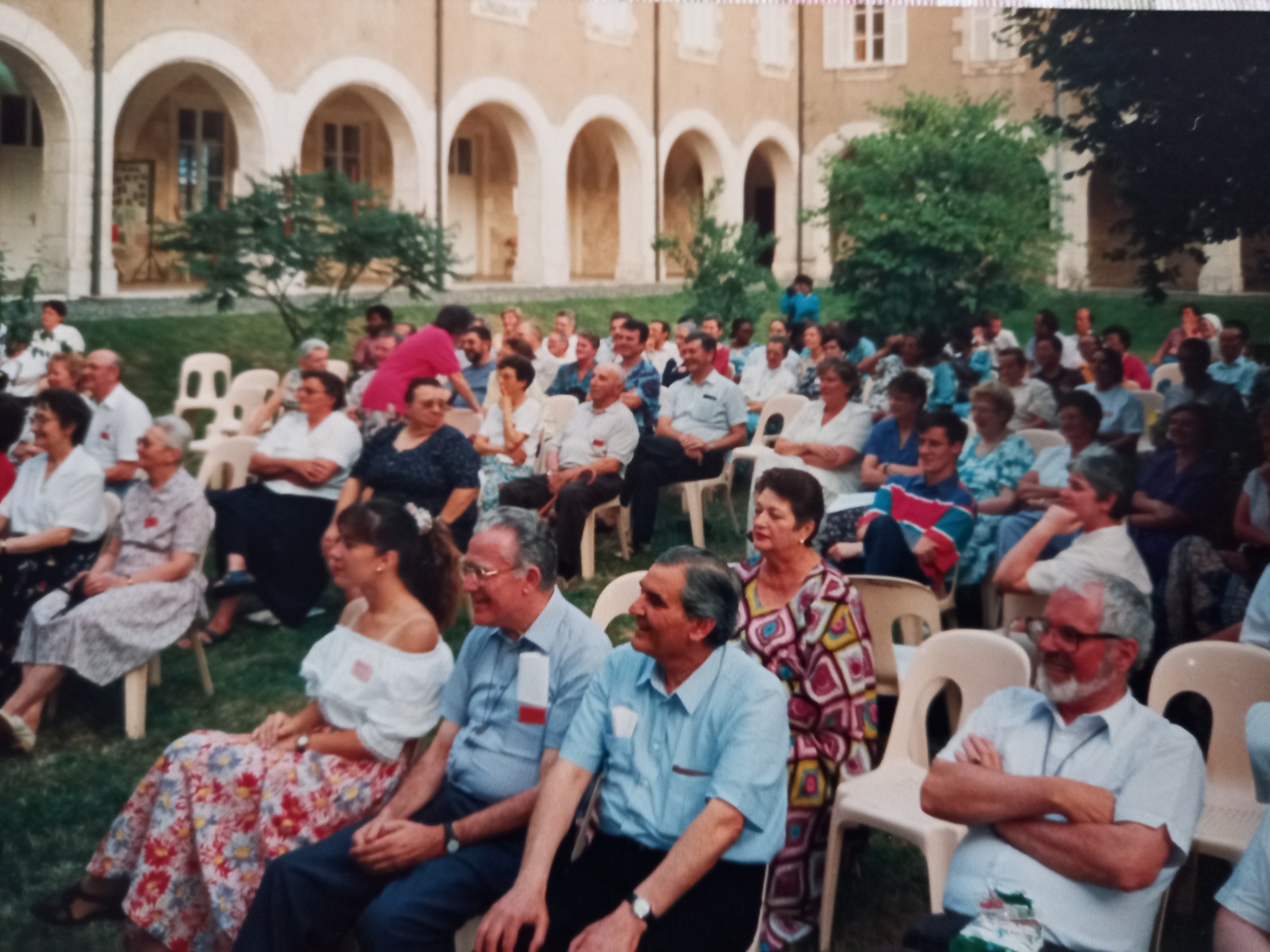 |
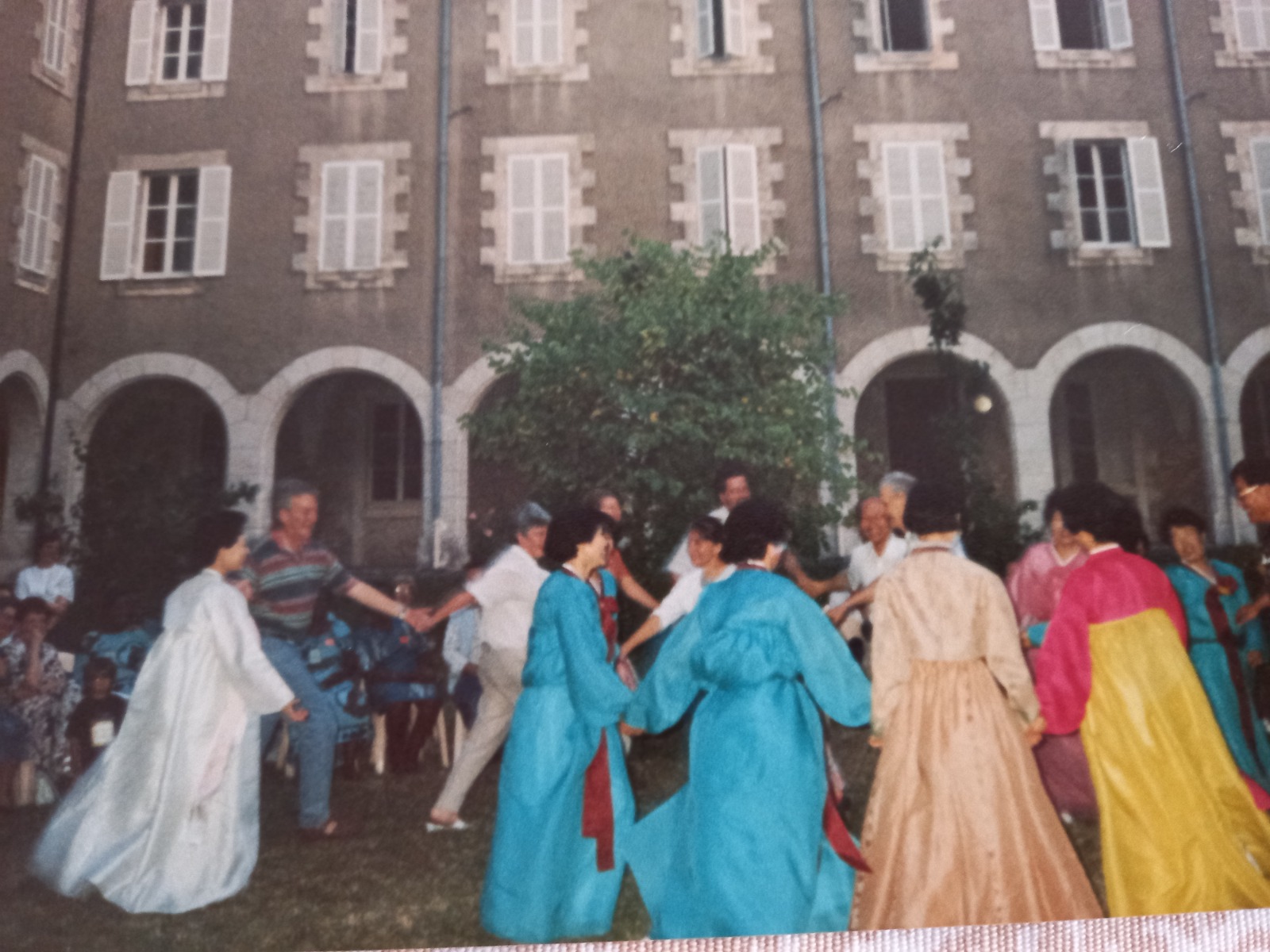 |
Historical photos from the first gathering of Laity
This meeting took place at the joint request of Fr Michael Curran, then MSC Superior General, and the Franco-Swiss MSC Province. That meeting led to the formation in 1997 of the steering committee of the Council of Laity of the Franco-Swiss MSC Province, with Louis Joly as co-ordinator.
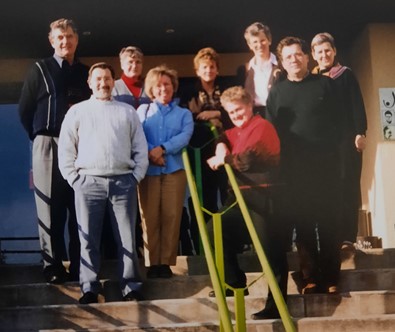 Photo: A meeting of the first European Lay Council.
Photo: A meeting of the first European Lay Council.
Fr Michael Curran MSC, General Superior, and Fr Chema MSC (from Spain) were visitors. The meetings were organised in Miribel near Lyon, and members stayed in the homes of family friends of Louis and Nadette.
(used with permission)
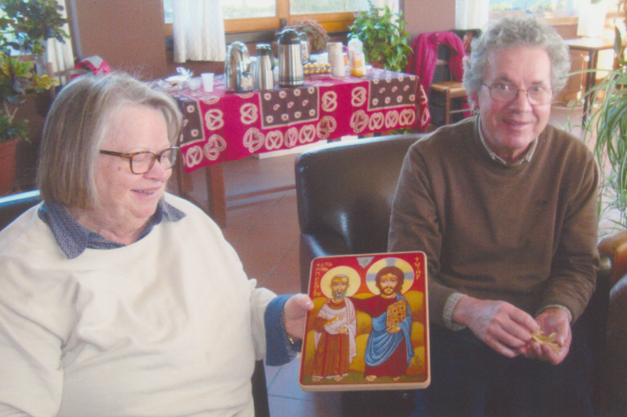 Photo: Louis and Nadette Joly. Louis died on October 7, 2020. (used with permission)
Photo: Louis and Nadette Joly. Louis died on October 7, 2020. (used with permission)
In 1999, the European Council invited the laity to attend another International Gathering in Issoudun and from that gathering, a global alliance was formed. This gathering was truly international with participants from many parts of the world, and it is regarded as the first of the International Assemblies.
Photos: Participants in the 1999 Gathering of the Laity in Issoudun.
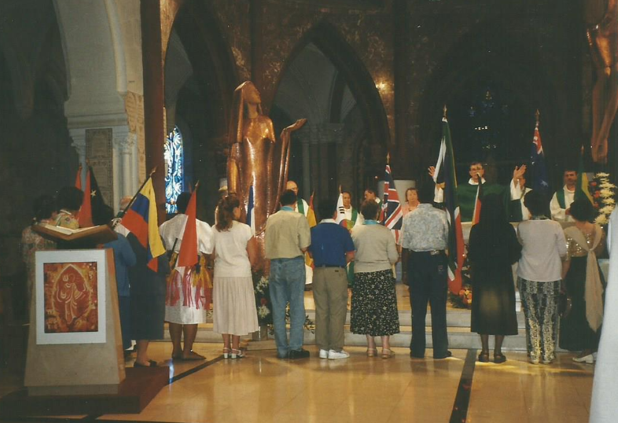
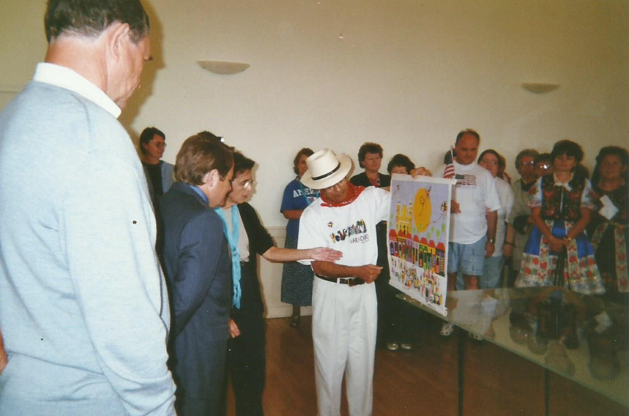

One aim of this meeting was to form an International Leadership Team, which occurred. In order to limit costs, membership was limited to European lay members from Belgium, France, Switzerland, Germany, Ireland, England, the Netherlands, Slovakia and Spain. There were seven founding lay members, as well as a representative from the three Congregations and a representative from the Chevalier Formation Centre, Cor Novum, Issoudun. The names of the founding members are:
Louis JOLY, president and treasurer (France)
Marie-Blanche CORDONIER, secretary (Switzerland)
Sue KIMBERLEY (England)
Mimi van POPPEL (The Netherlands)
Angeles FONDEVILA (Spain)
Sr Stephani ORLOWSKI MSC (Germany)
Rita CLEUREN (Belgium)
Sr Suzanne BEIGNON FDNSC, General Council representative (France)
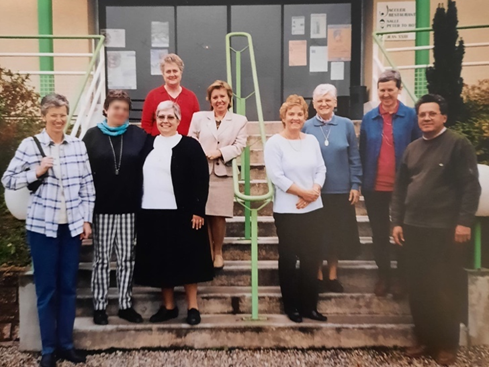 Photo: Participants in a meeting of the European Council , 2002, in Miribel (near Lyon) The photo includes Sr Barbara Daniels MSC (third on the left). (used with permission)
Photo: Participants in a meeting of the European Council , 2002, in Miribel (near Lyon) The photo includes Sr Barbara Daniels MSC (third on the left). (used with permission)
From 2000 onwards, the European Committee met twice each year in Lyon, France. The Committee recognised that it had an international mission and worked hard to stay in touch with the whole world and to create the collegial and structural foundation for the current structures.
Louis undertook the roles of Secretary General and Treasurer from 1999 to 2007 when Rita Cleuren, from Belgium succeeded Louis. The official headquarters of the international non-profit Association of Laity moved to Brussels in 2016.
The Franco-Swiss lay organisation had allocated considerable funds for the formation of their laity and they donated the entirety of these funds to the European Council of Laity. Administrative and accommodation costs for meetings were paid from this fund and the travel expenses to and from Lyon were borne by the European countries.
During this period, groups were also forming all around the globe and national and regional structures were beginning to develop, particularly in Southern and Central America.
The European Lay Council recognised the diversity that existed (and still exists) amongst a membership that comes from most continents and many, many countries and saw the need to organise another international meeting outside of Issoudun, thus the second International Assembly was held in 2008 in Santo Domingo, Dominican Republic. One of the goals of that meeting was to establish a fully-fledged International Lay Council. While significant progress was made towards the achievement of that goal, it was not fully realised until the third Assembly in Sao Paulo, Brazil.
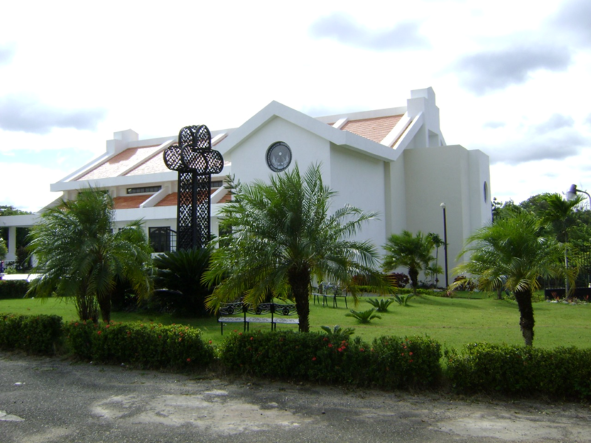 Photo: The meeting place for the second international Assembly, Escuela de Evangelización San Juan Pablo segundo. Santo Domingo in the Dominican Republic
Photo: The meeting place for the second international Assembly, Escuela de Evangelización San Juan Pablo segundo. Santo Domingo in the Dominican Republic
|
|
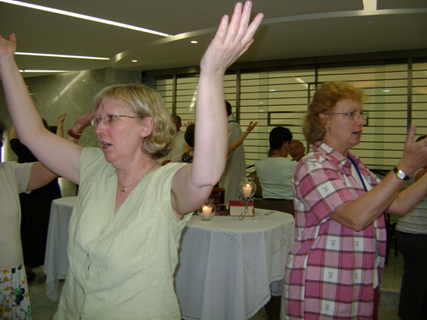 Elisabeth Hartmann (Germany) and Marie Pellish (USA) (used with permission) Elisabeth Hartmann (Germany) and Marie Pellish (USA) (used with permission) |
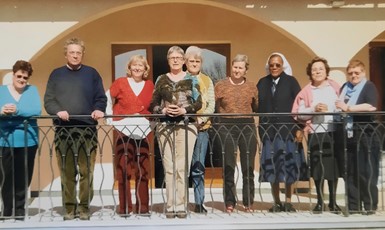 Photo: A later European Council: from the left to the right : Mimi van Poppel, Louis Joly, Elisabeth Hartmann, Hannie Jansen, Therese (a visitor from Germany), Rita Cleuren, Sr Relida Gumur FDNSC Trigen, Ana San Martn, Jozefa Meys. (Louis, Therese and Jozefa have died)
Photo: A later European Council: from the left to the right : Mimi van Poppel, Louis Joly, Elisabeth Hartmann, Hannie Jansen, Therese (a visitor from Germany), Rita Cleuren, Sr Relida Gumur FDNSC Trigen, Ana San Martn, Jozefa Meys. (Louis, Therese and Jozefa have died)
(used with permission)
Following the 2008 Assembly, the European Lay Council continued to work towards the goal of a truly international and representative Council of the Laity of the Chevalier Family. The connections between Europe and the wider global family grew stronger through visits to many parts of the world, fully funded by European laity and religious. Jozefa Meys, Hannie Jansen and Rita Cleuren were key figures in the work that occurred between 2008 and 2017 and the global family owes these tireless pioneers a great debt of gratitude.
Others who contributed were Sara Nash from England who succeeded Sue Kimberley, Sylvie Barghon from France who succeeded Marie-Blanche Cordonier from Switzerland, Helen Gabcova from Slovakia, Elena Cedrola and Anna Mazzonzelli from Italy.
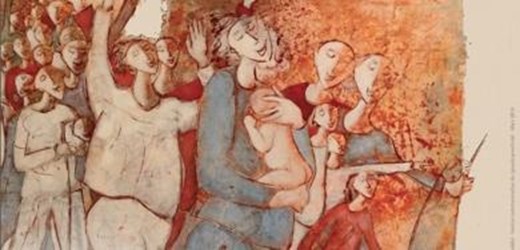 Image: Laity of the Missionaries of the Sacred Heart - France/Switzerland. (used with permission)
Image: Laity of the Missionaries of the Sacred Heart - France/Switzerland. (used with permission)
Throughout those early days the laity were accompanied by dedicated professed men and women who attended meetings in Miribel, Paris and Lyon. In particular, we thank:
MSC: Michael Curran, Mark McDonald, Nick Harnan, Fransiskus Wahyudi
FDNSC: Relida Gumur, Merle Salazar, Madeleine Ngoy
MSC Sisters: Barbara Winkler
The third International Assembly that was held in Sao Paulo, Brazil in 2017 was a turning point in the development of the lay movement. At that meeting a document of Guiding Principles and Statutes was accepted as the foundational organisational directions of the Laity of the Chevalier Family and an election was held for an International Council:
Alison McKenzie (Australia) was elected as General Secretary and Doris Machado (Brazil) as the Deputy. Rita Cleuren was invited to join the committee and Fr Hans Kwakman MSC continued as the Spiritual Companion to the Council. Since then, Peter Cheong from Korea has been invited to join as a member of the Council.
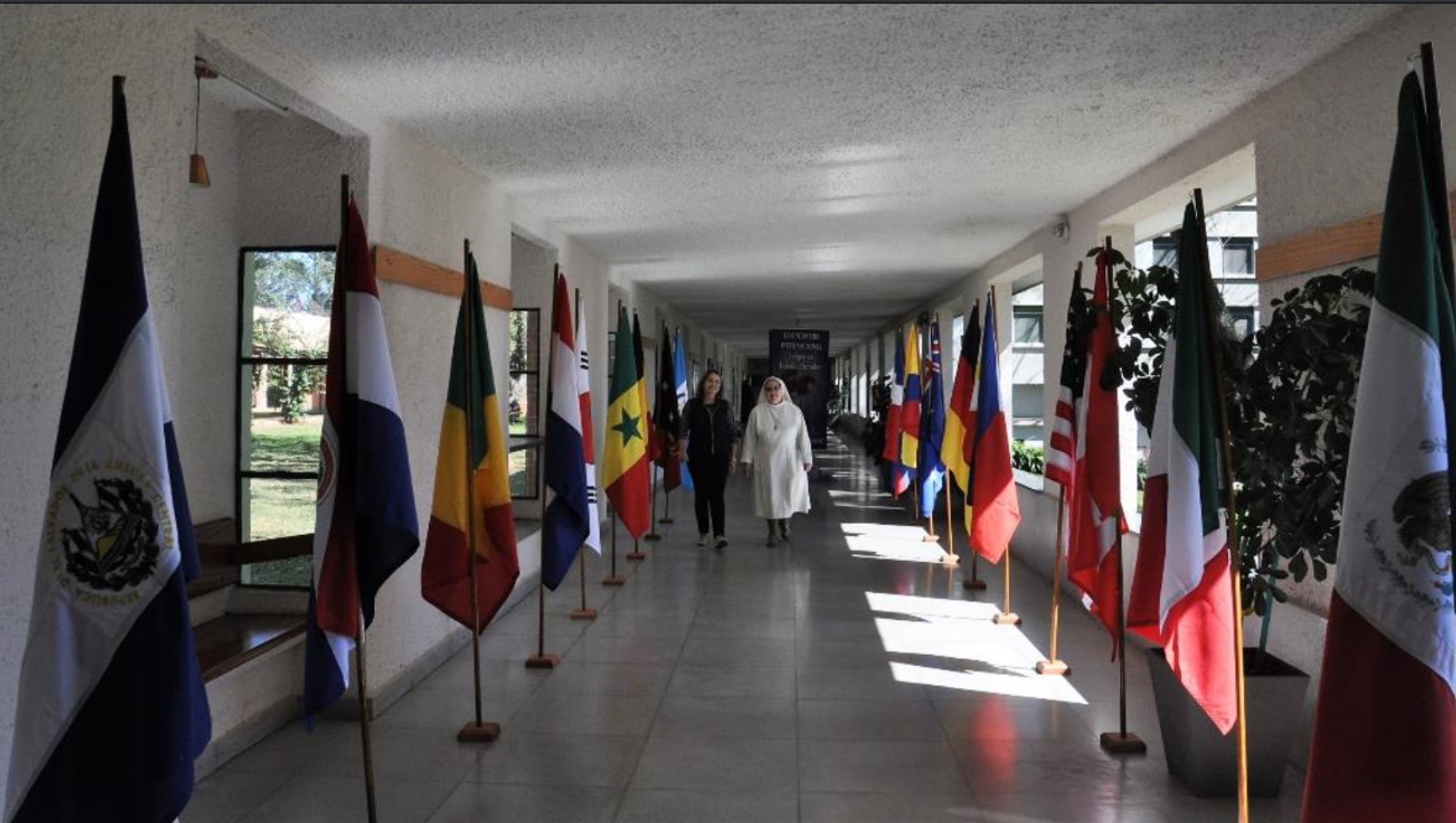 |
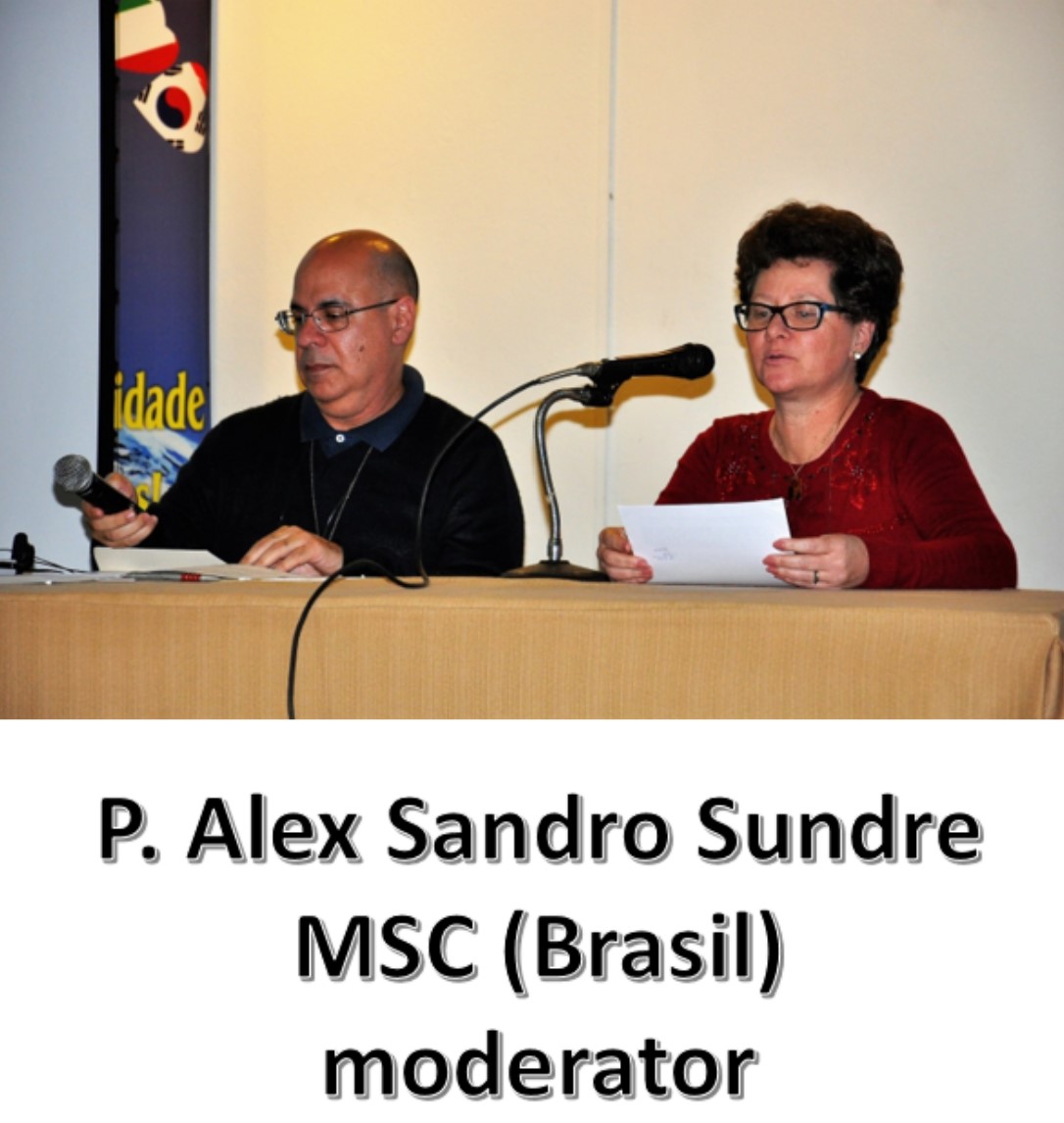 |
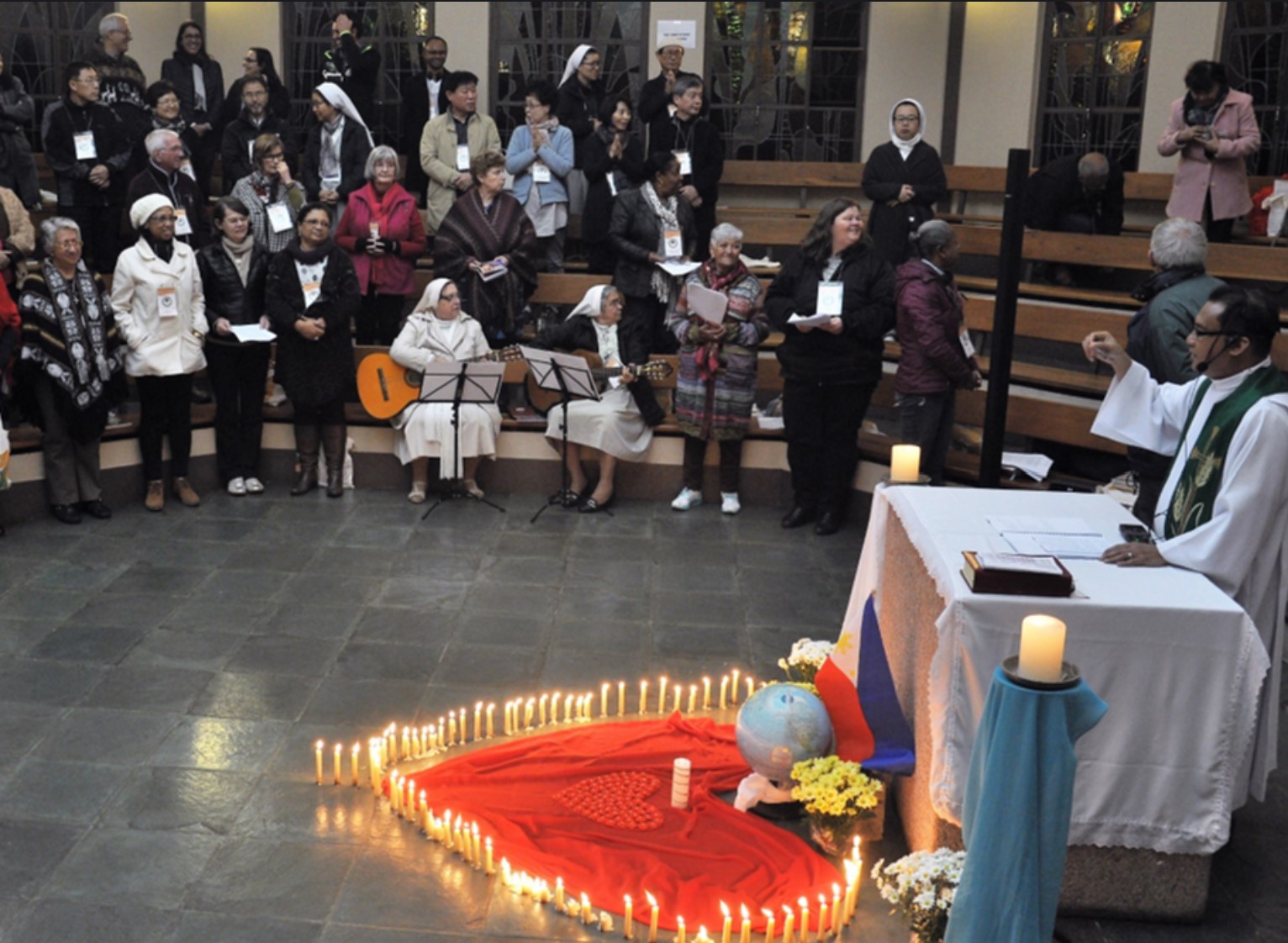 |
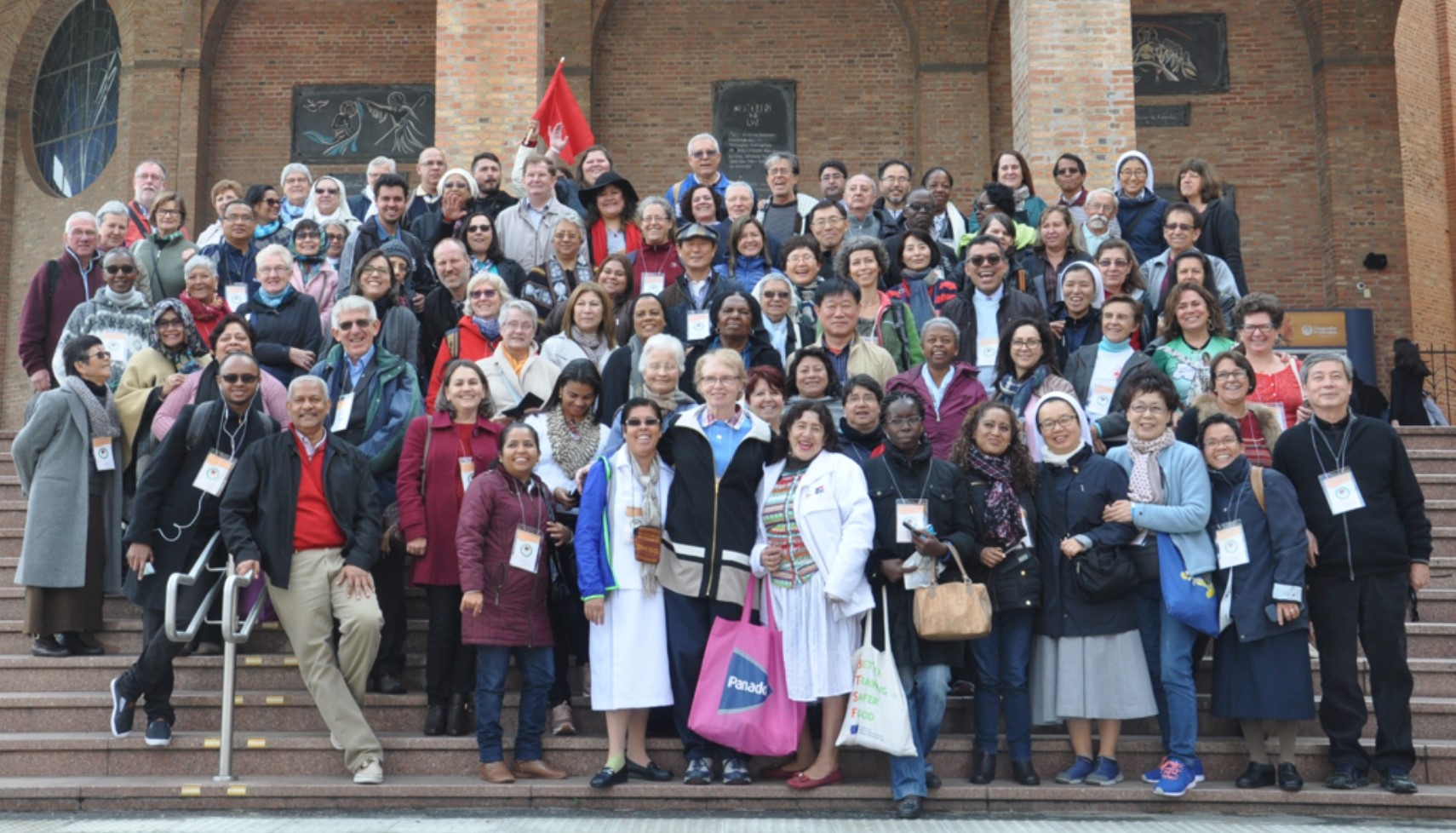 |
Photos above: Third International Assembly of the Laity
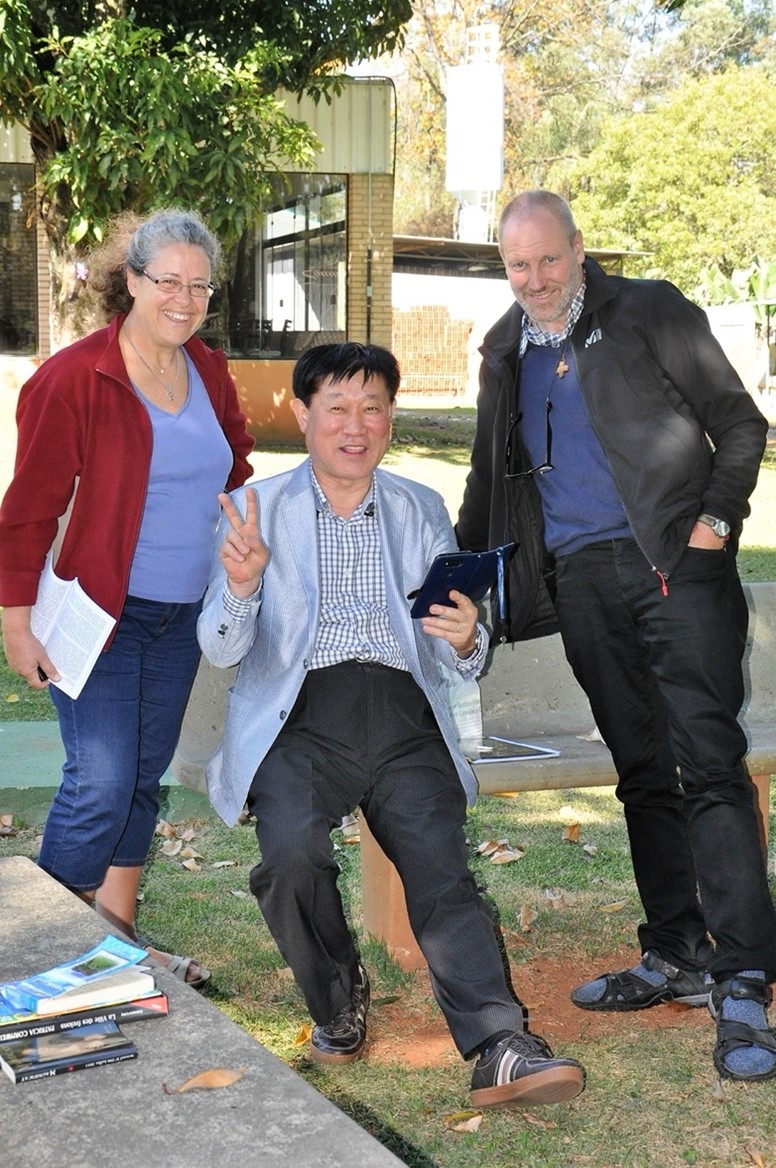 Photo: Sylvie Barghon, Peter Cheong and Jozef Bouwens in Sâo Paulo 2017
Photo: Sylvie Barghon, Peter Cheong and Jozef Bouwens in Sâo Paulo 2017
(used with permission)
The work continues and the documents on this website reflect the maturing understanding of the Laity of the Chevalier Family of their distinctive identity and their integral place in the Chevalier Family.
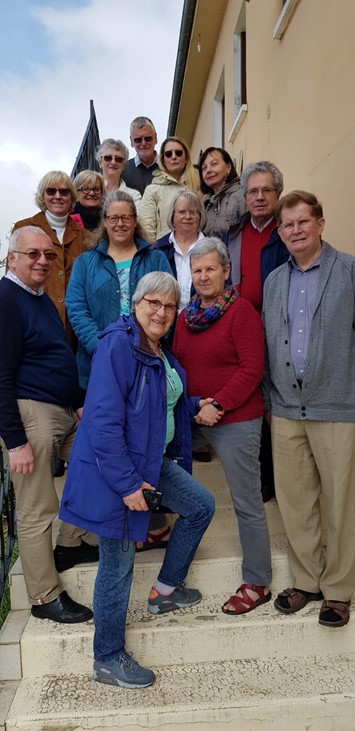 Photo: A recent image of the European Lay Council. Ian Nash (England), Sara Nash (England), Elena Cedrola (I) Anna Mazzonzelli (I), Helena Gabcova (Slovakia) Elisabeth Hartmann (Germany), Sylvie Barghon (F), Nadette Joly (F), Louis Joly. (F) Roland Douchin (F - Cor Novum - translator), Hans Kwakman MSC (NL) Hannie Jansen (N), Rita Cleuren (B)
Photo: A recent image of the European Lay Council. Ian Nash (England), Sara Nash (England), Elena Cedrola (I) Anna Mazzonzelli (I), Helena Gabcova (Slovakia) Elisabeth Hartmann (Germany), Sylvie Barghon (F), Nadette Joly (F), Louis Joly. (F) Roland Douchin (F - Cor Novum - translator), Hans Kwakman MSC (NL) Hannie Jansen (N), Rita Cleuren (B)
Used with permission
 General Guiding Principles and Organisational Directions of the Laity of the Chevalier Family
General Guiding Principles and Organisational Directions of the Laity of the Chevalier Family
After being reviewed and accepted by the General Assembly in January 2024, the final text of these amended “Guiding Principles and Organisational Directions” will be made available to the National Councils and Local Country Groups.
These “Guiding Principles and Organisational Directions” may be elaborated and specified in accordance with the local situation and cultural needs. However, faithfulness to the spirit of the Guiding Principles and adherence to the Organisational Directions is requested.
- pdf English Guiding Principles and Organisational Directions ICLCF [28 January 2024] (293 KB)
- pdf Español Principios Rectores y Directrices Organizativas ICLCF [28 January 2024] (296 KB)
- pdf Français Principes Directeurs et Orientations Organisationnelles ICLCF [28 January 2024] (290 KB)
PART I: GUIDING PRINCIPLES
- The Identity of the Laity of the Chevalier Family
- Charism and Spirituality of the Heart
- Mission
- Formation
- Resources
Section I.1: The Identity of the Laity of the Chevalier Family
We, the lay members of the Chevalier Family, are a communion of people, animated by a Spirituality of the Heart, which has its roots in the Holy Scriptures, as envisioned by Father Jules Chevalier and faithful to the charism he received and shared with others.
Together with the Missionaries of the Sacred Heart, the Daughters of Our Lady of the Sacred Heart, and the Missionary Sisters of the Sacred Heart, we belong to the Chevalier Family and share the same charism, spirituality, and mission with various religious congregations that were founded by or through the inspiration of Father Jules Chevalier or were inspired by a Spirituality of the Heart.
Section I.2: Charism and Spirituality of the Heart
We believe that Jesus’ compassionate Heart reveals God’s unconditional love for every human being and all of Creation. Belief in, or an experience of God’s unconditional love is what transforms our own hearts and is the remedy for the ills of society.
We draw strength from the pierced Heart of Jesus as a source of new life and the birthplace of a new world.
We trust in the Holy Spirit, who empowered Jesus Christ to love people unconditionally with a human heart. We also believe that the same Spirit enriches our hearts with gifts of love, gratitude, joy, courage, faithfulness, and respect for every human being and creature.
In Mary, honoured as “Our Lady of the Sacred Heart”, we discover a mother who guides us to the Heart of her Son and forms us in living a Spirituality of the Heart.
Our motto is “May the Sacred Heart of Jesus be loved everywhere.”
Section I.3: Mission
We participate in the mission of the Father, Son, and Holy Spirit in the world and are committed to living and spreading a Spirituality of the Heart, taking as a model the Heart of Jesus Christ.
Jesus was concerned about people and cared for their needs. His Heart went out to them, and he took action accordingly. In him, we experience that God has a heart for us, too. He calls us and sends us to be God’s Heart in today’s world. Our commitment to him and his mission gives our lives meaning and purpose.
In our personal relationships, professional occupations and social engagements, we try to make God’s love and compassion visible and real while paying particular attention to people experiencing poverty, exclusion, or unjust treatment.
We commit to a ‘greater love for our Creator, each other and the home we share’ (Laudato Si, 14). We recognise our interconnection with our Creator, each other, and Creation. Love and care for Creation is at the centre of the Spirituality of the Heart. We will advocate, educate, and celebrate actions that show our embodied love and care for our common home.
Section I.4: Formation
To answer our call to mission, we need formation. This formation is a life-long process that leads to an integration of Spirituality of the Heart into every aspect of our lives.
New members will be offered an initial formation program, and permanent members an ongoing formation program. Allowing ourselves to be formed by the experiences of daily life and by prayerfully reflecting on them in the light of the Gospel and our charism provides an opportunity to be constantly renewed.
Formation enables us to move from a personal encounter with a God of love to a life of mission and service in our families and communities and beyond.
Formation is necessary and an incentive to live Spirituality of the Heart joyfully.
Section I.5: Sources We Draw On
- The Word of God by reading and reflecting on the Holy Scriptures and living by it;
- Writings from the tradition of the Church, Papal Documents, and other publications reflecting a Spirituality of the Heart as lived, especially by the laity;
- Our understanding of the charism given to Jules Chevalier as entrusted to us through his life and writings and the development of these through the writings of others;
- The history of the Chevalier Family in the local area; Personal and communal prayer; and,
- The support of a group whose members try to live a Spirituality of the Heart.
PART II: ORGANISATIONAL DIRECTIONS
- Organisation
- Membership
- Finances
Section II.1: Organisation
The communion of lay members of the Chevalier Family consists of members who are related to any of the religious congregations founded by or through the inspiration of Father Jules Chevalier or inspired by a Spirituality of the Heart.
Some members are committed to living a Spirituality of the Heart as individuals, and others are committed to living the same spirituality while belonging to one of the local groups within their country.
Section II.1.1: Local Country Groups
Each Local Country Group of the Laity of the Chevalier Family:
- Is free to organise its local administration according to its needs and customs;
- May develop its own program while respecting the “Guiding Principles and Organisational Directions”; and,
- Will accept the accompaniment of the National Council of the Chevalier Family in the particular country (if there is one already) or, in the absence of a National Council, the accompaniment of the Chevalier Family congregation to which the Local Country Group is related.
Section II.1.2: National Councils
The National Council of the Laity of the Chevalier Family relies on the support and collaboration of the leadership of the Chevalier Family congregations in each country for its establishment.
As far as it is possible, the National Council will consist of one or more representatives of the local administration(s) of the lay group(s) in the country, together with one or more officially appointed representatives of the leadership of the Chevalier Family congregations present in that country.
The tasks of the National Council include:
- Acknowledging the Chevalier Family congregation leaders and their plans and collaborating with them;
- Encouraging and supporting the ongoing formation of the members in a Spirituality of the Heart;
- Ensuring that each Local Country Group has a Spiritual Companion, lay or religious, who practises and promotes a Spirituality of the Heart;
- Supporting collaboration of the administrations of the Local Country Groups with the wider Chevalier Family;
- Promoting the continuous presence of the Laity of the Chevalier Family in a country, even when religious congregations founded by or through the inspiration of Fr Jules Chevalier are no longer present in the country concerned; and,
- Sending, if possible, at least one representative to the General Assembly, preferably appointed by the National Council.
Section II.1.3: General Assembly
The General Assembly is a meeting of representatives of National Councils or local groups from different countries where members of the Laity of the Chevalier Family are present. It is called and organised by the sitting International Council of the Laity of the Chevalier Family. The General Assembly deals with matters of a general nature that are relevant to all participating groups. Upon the agreement of those present, decisions made by the General Assembly are binding on the groups represented at the General Assembly. These include the Local Country Groups, the National Councils, and the International Council.
The membership of the General Assembly is made up of the following persons:
- Members of the International Council of the Laity of the Chevalier Family; One representative of each country; and,
- In countries with a National Council, this representative is sent by the National Council. Each National Council will decide how this representative is chosen;
- In countries without a National Council, this representative is sent by the Local Country Groups. The Local Country Groups will agree among themselves how this representative is chosen;
- Other participants who would like to attend.
The following members of the General Assembly have the right to vote:
- One official representative of each country present at the General Assembly;
- Every member of the International Council.
A person is elected, or matters are determined, preferably by consensus or by a simple majority of votes. This means 50% plus one of the voting members present and participating in a particular vote.
The General Assembly will come together every six years.
The term of office for the General Secretary and the International Council members is for the six years between Assemblies. The General Secretary and Council members may serve no more than two terms of six years each.
The tasks of the General Assembly include:
- Reviewing the general situation and circumstances of the Laity of the worldwide Chevalier Family;
- Reflecting on and deepening their understanding of the Spirituality of the Heart and how it is lived;
- Evaluating the functioning of the sitting International Council;
- Reviewing and making amendments to these “Guiding Principles and Organisational Directions”;
- Electing the General Secretary and affirming the appointment of the members of the International Council; and,
- Making recommendations to the newly-elected International Council, including suggestions regarding the host country for the following General Assembly.
Section II.1.4: The International Council
The International Council is the international coordinating body of the Laity of the Chevalier Family. It calls, organises, and presides over the General Assembly. The role of the International Council is to exercise oversight over the General Assembly organisation in collaboration with the National Council of the host country. The International Council will assume responsibility for the General Assembly's program.
An International Council will be formed following the election of the General Secretary, based on nominations and invitations from the General Secretary and Spiritual Companion. The General Secretary will appoint a maximum of five members of the International Council after consulting the Spiritual Companion. In choosing the additional members of the International Council, the General Secretary will endeavour to have a balanced representation from the different parts of the world where lay members of the Chevalier Family are present.
The tasks of the International Council include:
- Determining how best to work together to carry out the vision of the International Council; Carrying out the recommendations of the General Assembly;
- Promoting unity in diversity among the various Local Country groups of the worldwide Chevalier Family per these “Guiding Principles and Organisational Directions”;
- Ensuring the communication and exchange of information among the various Local Country Groups in the worldwide Chevalier Family;
- Building a contemporary register of suitable formation resources for the Local Country Groups and making available, through different means, various formation resources; Promoting, in collaboration with the National Council or Local Country Groups of a particular country, the continuous presence of the Laity of the Chevalier Family, even when religious congregations founded by or through the inspiration of Fr Jules Chevalier are no longer present in the country concerned;
- Calling a General Assembly every six years;
- Drawing up the official list of countries with active members of the Laity of the Chevalier Family two years before the next General Assembly. Countries with “active members” are those with National Councils or Local Country Groups that regularly respond to communications from the International Council. Based on this list, invitations are sent for each country to send one official representative to the General Assembly; and,
- Keeping in regular contact with the Tri-Generalate for evaluation and planning.
Section II.1.5: Spiritual Companion
The International Council of the Laity of the Chevalier Family will be accompanied and supported by a Spiritual Companion. The Spiritual Companion can be lay or professed and is a member of the Council but without voting rights at the General Assembly. The role of the Spiritual Companion and the process for appointment to that role is outlined in the policy document entitled “Role of and Process for Appointment of the Spiritual Companion of the International Council of the Laity of the Chevalier Family, 20 September 2021”.
Section II.1.6: Tri-Generalate
The General Administrations of the three religious congregations related to Father Jules Chevalier and founded during his lifetime are collectively called the Tri-Generalate. They accompany the Laity of the Chevalier Family directly through their regular collaboration with the International Council and indirectly through the provincial/regional/union administrations of the three congregations in the different countries and the individual members of the congregations who are appointed as Spiritual Companions of the Local Country Groups.
Section II.2: Membership
Membership in a Local Country Group of the Laity of the Chevalier Family is possible for everyone who would like “to grow in love” (Chevalier) and live a Spirituality of the Heart, according to the charism expressed in the above-mentioned Guiding Principles. They may also be accepted by a local country group and/or the National Council as eligible for membership. Each National Council or local country group will determine their criteria for acceptance.
Membership of a Local Country Group and a National Council to the communion of the Laity of the Chevalier Family is established through regular communication with and financial contribution to the International Council.
Section II.3: Finances
Each Local Country Group determines how to raise funds for operating costs. Ideally, every member of a Local Country Group takes responsibility for and financially contributes to their own Local Country Group.
In the same way, each National Council determines how to raise the necessary funds to cover its operating costs. Ideally, each Local Country Group contributes to the National Council’s costs.
The International Council depends on the financial support of the National Councils and Local Groups in different countries. These contributions will help cover the expenses incurred in carrying out the responsibilities of the International Council.
Each National Council, or (in the absence of a National Council) the one Local Country Group has committed (at the General Assembly, January 2024) to financially supporting the work of the International Council with a minimum contribution of US$100 in June each year, unless alternate arrangements are made with the International Council.
The International Council has committed to transparent reporting on their financial activities in December of each year.
Alison McKenzie
General Secretary
International Council of the Laity of the Chevalier Family

